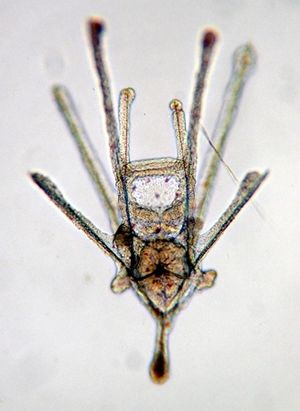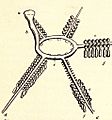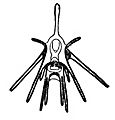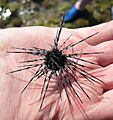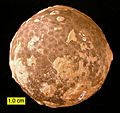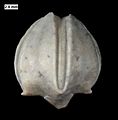Echinoderm facts for kids
Quick facts for kids EchinodermsTemporal range: Late Ediacaran-Recent
|
|
|---|---|
 |
|
| Sea urchin | |
| Scientific classification | |
| Domain: |
Eukaryota
|
| Kingdom: | |
| Subkingdom: | |
| Superphylum: | |
| Phylum: |
Echinodermata
|
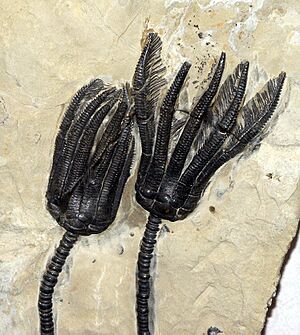
Echinoderms are a group of amazing marine animals. They live in the ocean and include familiar creatures like sea stars, brittle stars, sea urchins, and sea cucumbers. There are about 7,000 living species of echinoderms today.
These animals have some special features that make them unique:
- They have a skeleton made of plates. These plates are formed from a mineral called calcite, which is a type of calcium carbonate. The skeleton is often spiny and covered by a layer of skin.
- Most echinoderms have a five-part body plan. This means their bodies are arranged in five sections around a central point, like the arms of a starfish. This is called pentameral symmetry.
- They have a special "water-vascular system." This is an internal system of tubes and small sacs filled with water. It helps them move and eat.
- Connected to the water-vascular system are "tube feet." These are tiny, flexible tubes that stick out from their bodies. Echinoderms use their tube feet for walking, breathing, and catching food.
- Echinoderms are "stenohaline." This means they cannot handle big changes in the saltiness of the water.
- Because of this, all echinoderms live only in the ocean. You won't find them on land or in fresh water.
Echinoderms live in all parts of the ocean, but you'll mostly find them on the sea floor. Some of them filter tiny bits of food from the water. Others, like starfish, are important hunters that eat molluscs and other shellfish. They are very common near the shore and on reefs.
Contents
Types of Echinoderms
Scientists group echinoderms into different classes. Here are the main groups you might know:
- Asteroidea: These are the starfish, also known as sea stars. They are known for their star shape and often have five arms.
- Ophiuroidea: These are the brittle stars. They look a bit like starfish but have longer, thinner arms that can break off easily (and grow back!).
- Echinoidea: This group includes sea urchins and sand dollars. Sea urchins are round and covered in movable spines.
- Holothuroidea: These are the sea cucumbers. They have soft, tube-shaped bodies. Their skin is tough and often slimy, which helps protect them.
- Crinoidea: These are the sea lilies and feather stars. Sea lilies look like plants with stalks and feathery arms, while feather stars are free-swimming.
The stalked crinoids were very important on the sea floors long ago. They are a good example of how some fossil forms are important to study.
How Echinoderms Live
Most adult echinoderms have a body with five-part radial symmetry. This means their body parts are arranged around a central point. However, some, like sea cucumbers, have bilateral symmetry as adults, meaning their bodies can be divided into two similar halves. Sea cucumbers also have less of a hard skeleton than other echinoderms.
Echinoderms use their hydraulic water vascular system to move around, find food, and exchange gases. They also have a complete digestive system. Their nervous system is simple, like a net of nerves. They don't have a brain, but they do have nerve rings around their mouth with nerves extending into each arm. These nerves help coordinate their movements.
Most echinoderms move using their tube feet. Brittle stars can also use their arms to pull themselves along rocks. Some feather stars and sea cucumbers can even swim!
Reproduction and Life Cycle
Echinoderms usually have separate sexes. They reproduce by releasing eggs and sperm into the water, where fertilization happens. Their young, called larvae, are tiny and float in the water as plankton.
Many echinoderms are amazing at regeneration. This means they can regrow lost body parts. For example, if a starfish loses an arm, it can grow a new one. In some cases, a single arm with a small part of the central body can even regrow into a whole new starfish!
Echinoderm Larvae
While most adult echinoderms have radial symmetry and live on the sea floor, their larvae are very different. Echinoderm larvae are tiny, free-swimming organisms that float in the water. They have bilateral symmetry, which means they can be divided into two equal halves. This is similar to how early chordates (animals with a spinal cord) develop.
The first stage of most echinoderm larvae is called a dipleurula. It has a row of tiny hairs called cilia that help it swim. As the larvae grow, they are carried away from their parents by ocean currents. Later, the larval body changes and develops into the adult form, which usually has the five-part radial symmetry.
Echinoderm Evolution
Scientists don't have much geological evidence about exactly how echinoderms first appeared. The earliest definite fossils of echinoderms are found in rocks from the early Cambrian period. These fossils already show well-developed forms belonging to several different groups.
Some very old fossils, like Arkarua and Tribrachidium from the Ediacaran period, might be early echinoderms. Based on how animals are related, it seems that echinoderms, along with some similar groups, might have come from worm-like ancestors.
Interestingly, among all the animals without backbones, echinoderms are the closest relatives to the chordata. This group includes animals with a spinal cord, like vertebrates (fish, amphibians, reptiles, birds, and mammals). Echinoderms, chordates, and hemichordates are all part of a major animal group called deuterostomes.
Images for kids
-
Diagram of the water vascular system of a starfish, showing the ring canal, radial canals, and tube feet.
-
A sunflower star regenerating several arms.
-
A bilaterally symmetric echinopluteus larva with larval arms.
-
A blue Linckia starfish on a coral reef, a diverse underwater home.
-
Sea cucumbers used in traditional Chinese medicine.
-
A sea cucumber from Malaysia.
-
A sea urchin, Strongylocentrotus purpuratus.
-
A crinoid on a coral reef.
See also
 In Spanish: Echinodermata para niños
In Spanish: Echinodermata para niños


